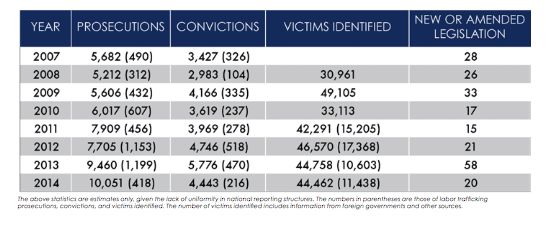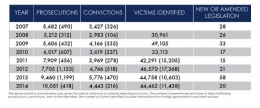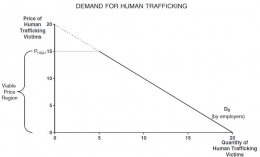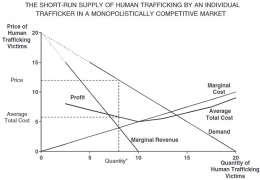First, human trafficking is driven by high rewards and low-risk dynamics. Profit is the main motive in the practice of human trafficking (Wheaton et al., 2009). The International Labor Organization (ILO) estimates that the profit generated from human trafficking and forced labor is 150 billion USD annually. In the case of international transactions, there are economic and political factors that open up opportunities for traffickers to seek profit. It is explained by Chuang (2004), who defines human trafficking as an opportunistic response to the tension between the economic need to migrate and the emergence of political motivation in the prohibition of migration policy.
High illegal profit opportunities combined with low-risk dynamics of detention and arrest support the increase in the occurrence of activities trafficking (Dank et al., 2014). In other words, traffickers can make the profit highest possible with minimal fear of punishment or legal consequences. There are still many countries in the world that lack preventive and repressive efforts from human trafficking. In a US Department report entitled Trafficking In Persons 2015, the estimated number of prosecutions and trials is minimal, and policymaking tends to be slow. The estimated number of individual prosecutions and constitutions in the report is much higher than the actual cases that can be identified. Law enforcement in countries that have laws is anti-trafficking described by Salt (2000), who argues that there is a tendency for lack of law enforcement in these countries.

Second, human trafficking is driven by the economic principle of supply and demand. Wheaton et al. (2009) modeled the human trafficking market with supply and demand, each determined by the decision-making of market participants. In terms of demand, employers or parties who employ victims of human trafficking are the determinants of demand, which can be associated with an increase in demand for certain goods by consumers. Higher demand leads to higher supply. An increase in the demand for an item by consumers raises the motivation for companies to hire workers with low wages, often even up to the lowest wage limit to exploit workers. The same thing happens with commercial sex. The increase in demand increases incentives for sex entertainment establishments to recruit and exploit minors. In terms of supply, the victims of human trafficking are the determinants of the demand side. Labor supply decisions then rest at the level of vulnerable individuals.
Third, systemic inequality and disparity make certain groups more vulnerable to exploitation through illegal migration. Othman (2006) then grouped several indicators of inequality and disparity into push and pull factors. Push factors are factors that affect the individual's desire to leave or move from the country and or community, such as inadequate job opportunities; poor living conditions; corruption and conflict (Ejalu, 2006; Wheaton, 2009); lack of access to basic needs; economic and political insecurity (Derks, 2000; Hughes, 2000; Wheaton et al., 2009); loss of livelihood; gender (Ehrenreich & Hoschild, 2006; Klueber, 2003); and natural disasters (Cormark, 2011). Then, the factor pull is a factor that influences an individual's decision to move to a particular place or community, such as ease of moving; more significant levels of wages and opportunities (Bales, 2000); stability of the migration path in the destination area; and the active demand for migrant workers and high expectations underpinned by global media, the internet, and the experiences of previous migrants (IOM, 2008; Aronowitz, 2009; Danailova-Trainor and Laczko, 2010).
Research conducted by Mahmoud (2009) on 5,513 households from Belarus, Bulgaria, Moldova, Romania, and Ukraine regarding the relationship of illegal migrants to trafficking shows similar results. This study's findings are those migrant families in crowded areas of migrants and large migrant networks are more likely to become victims of trafficking than other community groups in the same place.
The Economic Impact of Trafficking in Persons
Lost Resources
Human trafficking targets people who, in economic analysis, are seen as human resources. The impact of human trafficking is the loss of all or part of the production capacity of the production process that these human resources should have carried out. Victims are employed illegally and are not registered in economic activity. Furthermore, the victim's recovery process takes a long time and is complex, with no definite guarantee of recovery (UNODC, 2008). Trauma and psychological damage then affect individual behavior, making returning individuals to the labor market challenges. As a result, the accumulation of human capital will be lower than it should be, and the labor force participation rate will also decrease.
In a broader scope, the country where the victim is located will experience the potential to lose some of the tax revenue that should be used for development purposes. Activities related to trafficking that are not recorded are not taxable. UNODC (2008) even reported potential net income losses due to tax evasion and money laundering. In addition, the burden of rehabilitation and repatriation of victims borne by the origin country requires the public, in general, to pay more taxes to bear the additional burden.
Remittances













